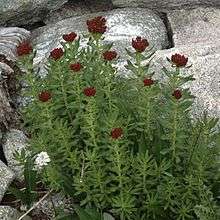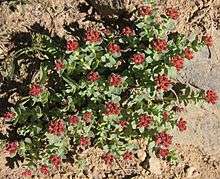Rhodiola integrifolia
| Rhodiola integrifolia | |
|---|---|
 | |
| Scientific classification | |
| Kingdom: | Plantae |
| (unranked): | Angiosperms |
| (unranked): | Eudicots |
| (unranked): | Core eudicots |
| Order: | Saxifragales |
| Family: | Crassulaceae |
| Genus: | Rhodiola |
| Species: | R. integrifolia |
| Binomial name | |
| Rhodiola integrifolia Raf. | |
| Synonyms | |
|
Sedum integrifolium | |


Rhodiola integrifolia is a species of flowering plant in the stonecrop family known by the common names ledge stonecrop,[1] western roseroot, and king's crown. It is native to north-easternmost Russia, including Kamchatka, and western North America, where it grows in mountainous habitat in subalpine and alpine climates, including meadows, cliffs, and talus. It is a perennial herb producing a stout stem from a fleshy, branching caudex, reaching a maximum height near 30 centimeters. The fleshy leaves are alternately arranged on the stem, widely lance-shaped to oval and pointed, flat but upcurved toward the tip, reaching 2.5 centimeters long. They are green when new and age to orange, rose, or red. The inflorescence is a dense cyme of up to 50 flowers with fleshy petals in shades of bright red to deep purple. The fruits are red, rounded ovals with pointed tips.[2]
There are several subspecies of this plant, with one, ssp. leedyi, very rare and limited to a few populations in Minnesota and upstate New York.[3] This subspecies is considered a relict from times when its range was covered in glaciers; it survives on barren cliffs which are kept cold by air blowing through cracks from subterranean caves.[3] It is treated as a federally listed threatened species in the United States.[3]
References
- ↑ "Rhodiola integrifolia". Natural Resources Conservation Service PLANTS Database. USDA. Retrieved 21 October 2015.
- ↑ Elizabeth Wenk (2015). Wildflowers of the High Sierra and John Muir Trail. Wilderness Press. ISBN 978-0-89997-738-6.
- 1 2 3 Center for Plant Conservation
External links
- Jepson Manual Treatment
- USDA Plants Profile
- Washington Burke Museum
- Photo gallery
- Flora of the U.S.S.R. (as R. atropurpurea)
| Wikimedia Commons has media related to Rhodiola integrifolia. |